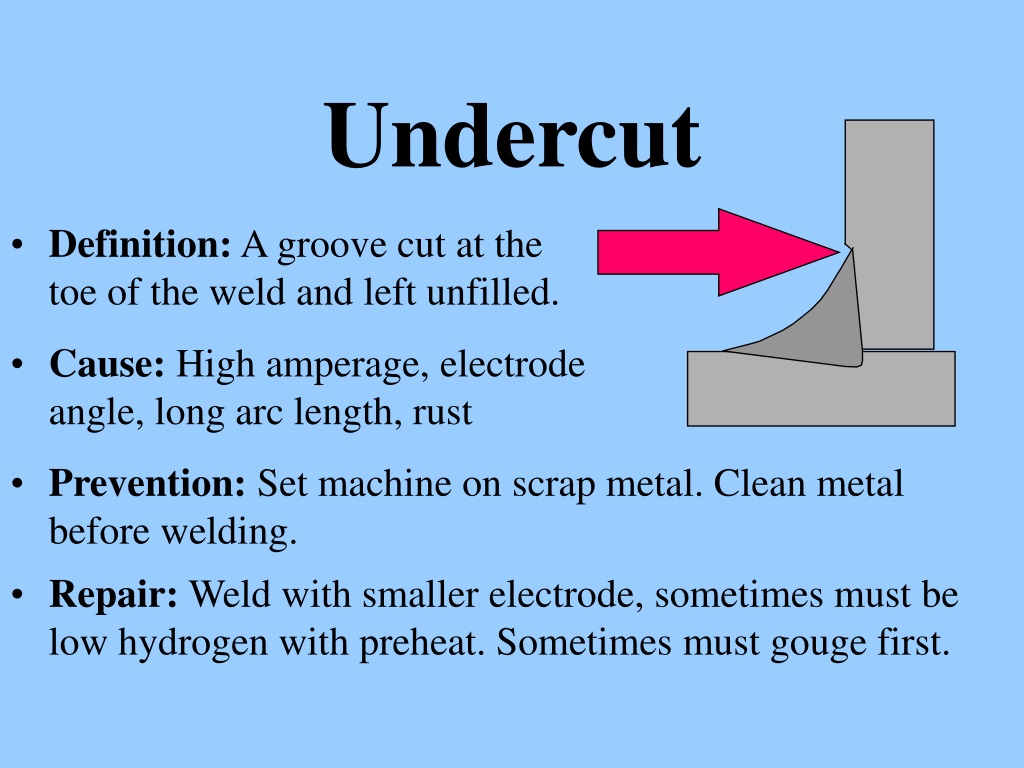Best Overview to Preventing Weld Undercut: Tips and Techniques
Best Overview to Preventing Weld Undercut: Tips and Techniques
Blog Article
Recognizing the Causes and Solutions for Undercut Welding in Metal Construction Processes
In the world of metal construction processes, the event of undercut welding positions a significant obstacle that demands an extensive understanding of its reasons and feasible remedies. The detailed interplay of numerous elements throughout welding procedures can result in this unwanted phenomenon, affecting the architectural stability and total top quality of the welded joints - Preventing weld undercut. By studying the root creates of undercut welding and checking out reliable restorative actions, makers can boost the criterion of their craftsmanship and make certain the production of flawless steel parts
Usual Reasons For Undercut Welding
Frequently forgotten in metal construction, undercut welding takes place due to various aspects that demand precise interest and competence to be effectively alleviated. One usual root cause of undercut welding is too much heat input. When the warm input is too high, it can cause the melting and subsequent erosion of the base product along the sides of the weld joint, developing a groove or undercut. In addition, improper welding methods, such as utilizing the incorrect welding angle or take a trip rate, can additionally add to undercut development. Inadequate securing gas protection is an additional essential aspect that can cause damaging. Not enough gas coverage falls short to shield the weld pool adequately, leading to oxidation and undercut issues. Additionally, the selection of welding specifications, such as voltage, present, and cable feed rate, plays a significant role in the occurrence of undercut welding. Understanding these common reasons is essential for implementing safety nets and guaranteeing high-quality welds in metal manufacture processes.
Influence of Incorrect Welding Parameters
Inaccurate welding specifications can substantially compromise the honesty and quality of bonded joints in metal construction processes. The influence of inaccurate welding parameters materializes in numerous means, leading to structural weak points and defects in the bonded elements. Careful attention to welding specifications is vital to make certain the manufacturing of high-quality welds with the wanted mechanical homes and structural honesty.
Impact of Improper Lantern Angle
Inappropriate lantern angle in welding procedures can considerably influence the high quality and stability of the last weld joints in steel construction procedures. Damaging is a typical welding defect where a groove forms along the weld toe, deteriorating the joint and endangering its architectural integrity.
A torch angle that is as well steep can result in inadequate penetration, incomplete blend, and increased spatter. On the various other hand, a lantern angle that is too shallow can result in extreme infiltration, burn-through, and distortion of the base material. Preventing weld undercut. Proper torch angle is important for guaranteeing regular weld quality, strength, and look
To stop damaging and various other issues brought on by improper lantern angles, welders must be educated to maintain the proper torch angle throughout the welding process. Normal surveillance and change of lantern angles during welding can help accomplish audio welds with minimal defects.
Function of Inadequate Welding Methods

An additional aspect of insufficient welding strategies is improper weld prep work. Insufficient cleaning of the base steels, incorrect joint design, or not enough edge preparation can all add to damage welding. Furthermore, inadequate protecting gas coverage or utilizing the incorrect sort of gas can cause insufficient blend and the formation of undercut flaws.
To attend to the role of poor welding techniques in metal manufacture procedures, it is vital to offer thorough training for welders. Correct education and learning on welding criteria, joint prep work, and protecting gas option can aid avoid undercut welding and ensure high-quality welds in metal construction tasks.
Effective Solutions for Undercut Welding
Dealing with undercut welding in steel construction requires executing reliable services to improve weld high quality and architectural integrity. Among the primary services to combat undercut is to change welding criteria such as voltage, present, and take a trip rate to make sure proper warm input and blend. By fine-tuning these setups, welders can prevent excessive melting of the base steel and filler material, reducing the chance of undercut development.
Additionally, appropriate joint prep work is vital in stopping undercut. Ensuring clean base metal surfaces without pollutants and utilizing go now the ideal bevel angle can assist advertise better weld penetration and decrease the threat top article of undercut - Preventing weld undercut. Utilizing suitable welding methods, such as oscillating the torch or weaving, can also help in dispersing heat uniformly and loading the weld joint effectively, minimizing the opportunity of undercut flaws
Additionally, picking the correct welding consumables, consisting of electrodes and filler metals, is crucial in alleviating undercut. Utilizing materials with proper chemical structures and mechanical residential properties can contribute to achieving audio welds with very little undercut. Normal inspection and high quality control procedures should additionally be implemented to discover and resolve undercut concerns without delay, guaranteeing the general stability of fabricated metal elements.

Conclusion
To conclude, recognizing the causes and options for undercut welding in steel fabrication procedures is essential for accomplishing premium welds. By dealing with typical causes such as inaccurate welding parameters, incorrect torch angle, and insufficient welding strategies, welders can protect against damaging and guarantee solid, long lasting welds. It is important to take notice of these elements and apply efficient remedies to enhance the total welding procedure and final product high quality.

Report this page